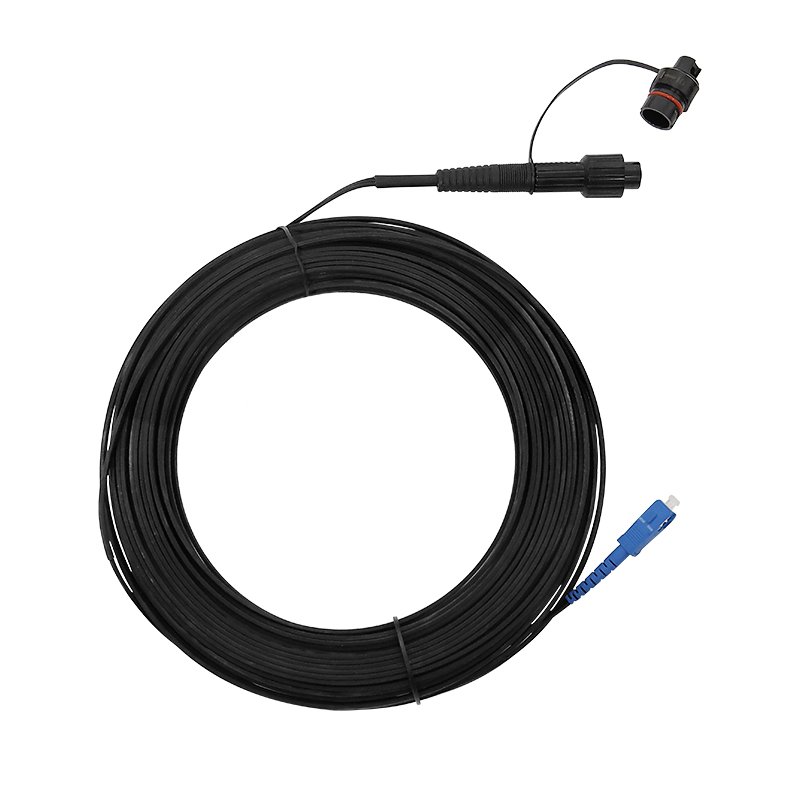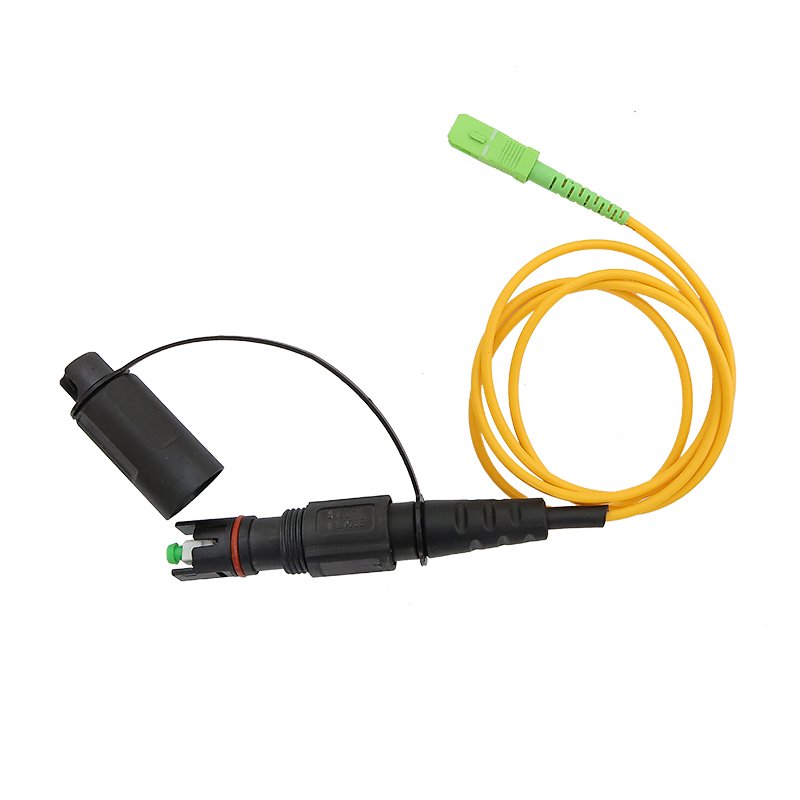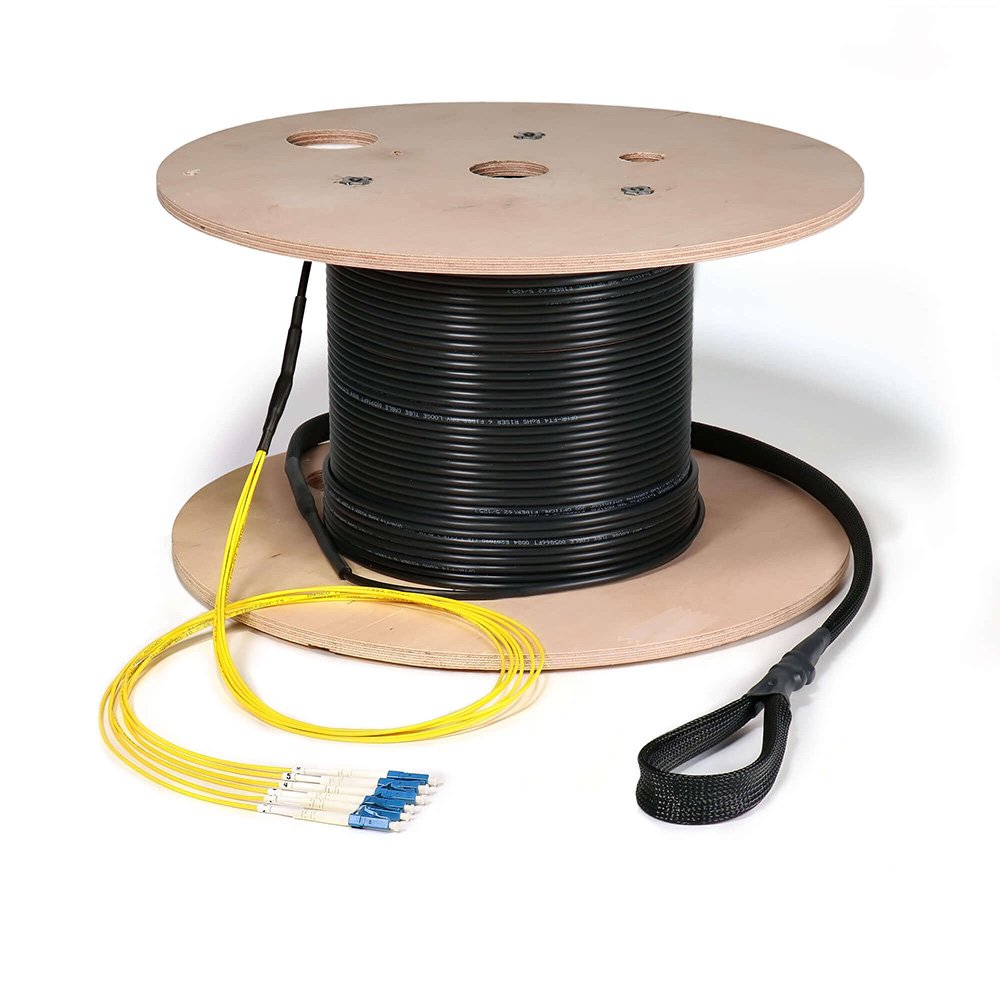As of August 04, 2025, the telecommunications landscape is evolving rapidly, driven by the rollout of 5G, the expansion of cloud services, and the rise of smart infrastructure. Pre-terminated fiber cables have become a cornerstone of this transformation, offering pre-installed connectors that accelerate deployment and enhance reliability. This guide provides an in-depth exploration of pre-terminated fiber cable construction, benefits, applications, installation best practices, and future trends. Tailored for professionals sourcing solutions from CommMesh, it equips you with the knowledge to optimize network performance in today’s demanding market.
What is a Pre-Terminated Fiber Cable?
A pre-terminated fiber cable is a fiber optic cable delivered with factory-installed connectors—such as SC, LC, or MPO—eliminating the need for on-site splicing or termination. The optical fiber, consisting of a core (8–62.5 μm) and cladding (125 μm total diameter), is the light-transmitting element, encased in protective layers and pre-aligned connectors. These cables are tested to ensure low insertion loss (<0.3 dB) and high return loss (>-50 dB), making them ready for immediate use.

This approach contrasts with traditional cables, where field splicing with a fiber optic splicer machine can introduce 0.1–0.5 dB loss per joint. Pre-terminated cables leverage precision manufacturing, with connector alignment achieved to ±0.1 μm accuracy. As of mid-2025, their adoption has surged, with over 500,000 km deployed globally (per CRU Group), supporting applications from data centers to rural broadband. Each fiber can handle 400 Gbps via wavelength-division multiplexing (WDM), with multi-core variants (e.g., 144 cores) offering terabit-scale capacity.
Construction of Pre-Terminated Fiber Cables
The construction of pre-terminated fiber cables balances optical performance with mechanical durability:
- Optical Fiber
- The core, made of ultra-pure silica (99.9999% purity), carries light via total internal reflection, with a refractive index of 1.46. Cladding (refractive index ~1.44) confines light, reducing attenuation to 0.2 dB/km for single-mode and 1–3 dB/km for multimode.
- Single-mode fibers (8–10 μm) suit long-haul (100 km), while multimode (50–62.5 μm) targets short runs (2 km). Dopants like germanium or fluorine fine-tune optical properties.
- Buffer Coating
- A 250 μm acrylate or silicone buffer protects the fiber from moisture and micro-bends, offering tensile strength of 600–1000 N. This layer mitigates 0.1–0.5 dB loss from external pressure.
- Temperature stability ranges from -40°C to 85°C, critical for 2025’s variable climates.
- Strength Members
- Aramid yarn (Kevlar) or fiberglass rods provide 1000–3000 N tensile strength, absorbing loads during installation or burial (e.g., 50 kN/m² soil pressure at 1.0-meter depth).
- These members ensure a 10–30 mm bend radius, preventing 0.01% signal loss.
- Jacket
- A polyethylene or LSZH jacket (5–10 mm thick) offers UV resistance, water ingress protection (IP68, 0.1 MPa), and abrasion resistance. Armored versions with steel tape add 1000 N strength for harsh environments.
- Color coding (e.g., blue for single-mode) aids identification.
- Pre-Installed Connectors
- Connectors like LC, SC, or MPO are polished to a 0.3 μm finish, with insertion loss <0.3 dB and return loss >-50 dB. Factory testing includes 1000 mating cycles, ensuring durability.
- Alignment is precise to ±0.1 μm, reducing field adjustments by 90%.

Advantages of Pre-Terminated Fiber Cables
Pre-terminated fiber cables offer significant technical and economic benefits:
- Reduced Installation Time
- Traditional splicing takes 5–10 minutes per joint with a fiber optic splicer machine, while pre-terminated cables enable plug-and-play connections, reducing 100-meter installs from 3 hours to 1 hour—a 70% time saving.
- Critical for 5G deployments, where downtime costs $10,000/hour.
- Lower Labor Costs
- Eliminating splicing cuts labor by 50–60%, saving $500–$1000 per kilometer. No need for skilled splicers reduces training costs by 40%.
- Example: A 2025 Verizon project saved $2 million on a 2000 km rollout.
- Improved Reliability
- Factory-tested connectors ensure <0.3 dB loss per connection, versus 0.1–0.5 dB for field splices. Return loss >-50 dB minimizes reflections, enhancing signal quality.
- Reduces failure rates by 30% over 10 years, per industry data.
- Scalability
- Multi-core cables (12–144 cores) support future upgrades, with each core handling 400 Gbps via WDM, totaling 57.6 Tbps for a 144-core cable. Ribbon designs save 40% duct space.
- Adapts to 2025’s 800 Gbps data center demands.
| Benefit | Impact | Comparison to Splicing |
|---|---|---|
| Installation Time | 70% reduction | 1 hour vs. 3 hours/100 m |
| Labor Cost | 50–60% savings | $500–$1000/km saved |
| Loss (dB) | <0.3 | 0.1–0.5 (splicing) |
| Scalability | 12–144 cores | Limited by splice points |
Applications of Pre-Terminated Fiber Cables
Pre-terminated fiber cables are versatile, addressing diverse network demands:
- Data Centers
- High-density MPO connectors (e.g., 12–24 fibers) support 400 Gbps links over 100 meters, meeting the needs of AI-driven workloads. A 144-core pre-terminated cable can deliver 57.6 Tbps, critical for hyperscale facilities.
- Case Study: Google’s 2025 Singapore data center uses 96-core pre-terminated cables, reducing deployment time by 60% and supporting 800 Gbps interconnects.
- Technical Note: Requires <0.3 dB loss per connector, tested at 1310 nm and 1550 nm.
- Enterprise Networks
- LC duplex pre-terminated cables connect office LANs, delivering 10–100 Gbps over 500 meters. Their plug-and-play design minimizes downtime during upgrades by 80%.
- Example: A 2025 Cisco enterprise rollout in Tokyo deployed 50 km of 24-core cables, cutting installation costs by $300,000.
- Technical Note: Bend radius of 20 mm ensures 0.01% signal loss in tight spaces.
- FTTH Deployments
- Pre-terminated drop cables with SC or LC connectors simplify last-mile connections, reducing installation from 2 hours to 30 minutes per home. This supports the 30% FTTH growth in Europe by mid-2025 (per FTTH Council).
- Case Study: Orange’s France rollout used 100,000 pre-terminated drops, saving 5000 labor hours.
- Technical Note: Burial at 0.6–0.9 meters requires IP68 enclosures.
- 5G Infrastructure
- Multi-core cables (e.g., 24-core) support backhaul and fronthaul, delivering 25 Gbps per cell site. Pre-terminated designs accelerate 5G deployment by 50%.
- Example: Nokia’s 2025 trials in Finland deployed 200 km of 12-core cables, achieving 99.9% uptime.
- Technical Note: Tensile strength of 2000 N handles aerial installations.

Installation Considerations for Pre-Terminated Fiber Cables
Proper installation ensures optimal performance:
- Connector Handling
- Avoid touching connector end-faces—use dust caps and clean with 99% isopropyl alcohol to prevent 0.1 dB loss from 10 μm particles. Inspect with 200x magnification for scratches.
- Technical Note: Return loss drops to -40 dB with contamination, per TIA-568-C standards.
- Cable Routing
- Maintain a 10–30 mm bend radius to avoid 0.01% signal loss. Use cable trays or ducts (e.g., 40 mm inner diameter) for organized runs.
- Burial depth: 0.9–1.2 meters in urban areas, with 50 kN/m² soil pressure resistance. Aerial installs require 1000 N tensile strength.
- Testing and Verification
- Use an OTDR to measure insertion loss (<0.3 dB per connector) and reflection (>-50 dB) at 1310 nm and 1550 nm. A power meter verifies 0.01 dB accuracy.
- Technical Note: Test after 1000 mating cycles to ensure durability, as per IEC 61753-1.
- Environmental Protection
- Seal connectors with IP68-rated enclosures (0.1 MPa water resistance) and use heat-shrink sleeves for 200 N extra strength.
- Armored cables handle 1000 N/cm crush loads in rocky terrains, common in 2025 rural projects.

Challenges and Solutions
Pre-terminated fiber cables present some hurdles, addressable with strategic approaches:
- Cost
- Higher upfront cost ($1–$5/meter vs. $0.50–$2 for raw cable) due to connectors. Solution: Bulk orders reduce per-unit cost by 20%, and custom lengths minimize waste.
- Example: A 2025 AT&T order of 5000 km saved $1 million with bulk pricing.
- Length Limitations
- Fixed lengths (e.g., 10, 20, 50 meters) require precise planning, risking 10% excess material. Solution: Manufacturers offer custom cuts to ±0.1 meter accuracy.
- Technical Note: Excess length increases storage costs by 5%.
- Connector Damage
- Field mishandling causes 5–10% failure, with 0.2 dB loss from scratches. Solution: Training and protective caps reduce damage by 80%.
- Case Study: A 2025 Vodafone project trained 100 technicians, cutting failures by 7%.
- Scalability Constraints
- Connector density limits core counts to 144, capping capacity at 57.6 Tbps. Solution: Transition to 288-core MPO designs, expected by late 2025.
- Technical Note: Higher densities require 0.05 dB splice precision.
Future Trends in Pre-Terminated Fiber Cables
As of August 2025, several innovations are shaping the future:
- Higher Core Counts
- 288-core pre-terminated cables are in testing, promising 115.2 Tbps capacity with 0.2 dB/km loss. Prototypes from Corning target 2026 deployment.
- Technical Note: Requires MPO-24 connectors with 0.1 μm alignment.
- Smart Connectors
- IoT-enabled connectors with real-time loss monitoring (0.01 dB resolution) are emerging, reducing maintenance by 15%. Trials by Nokia in 2025 show 99% accuracy.
- Application: Predictive maintenance for 5G networks.
- Sustainability
- Bio-based jackets, cutting carbon footprint by 10%, align with 2025 green initiatives. LSZH materials reduce smoke toxicity by 90% in fires.
- Example: A 2025 EU project replaced 10,000 km of PVC jackets with bio-alternatives.
- Automation Integration
- Robotic installation systems for pre-terminated cables are in development, aiming to cut labor by 30% by 2027. Pilot tests in Japan show 50 m/hour efficiency.
- Technical Note: Requires 1000 N tensile handling capacity.
Conclusion
Pre-terminated fiber cables represent a leap forward in network deployment, offering pre-installed connectors that reduce installation time, lower costs, and enhance reliability. Their construction—featuring robust cores, buffers, strength members, and jackets—supports applications from data centers to 5G infrastructure. Despite challenges like cost and scalability, innovations like higher core counts and smart connectors promise a future of efficiency and sustainability. For telecom professionals, adopting pre-terminated solutions ensures competitiveness. Discover advanced options at commmesh.com.

